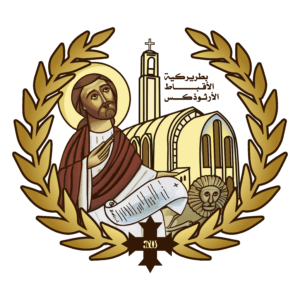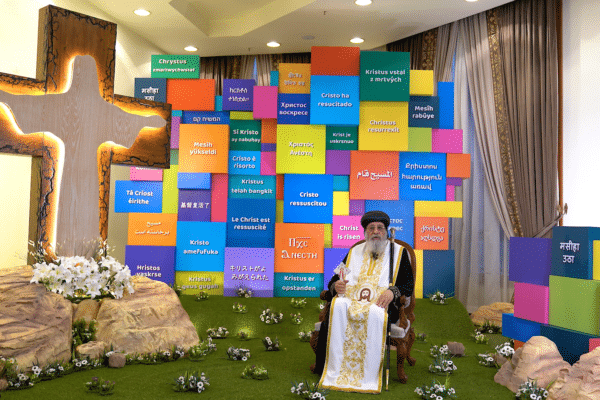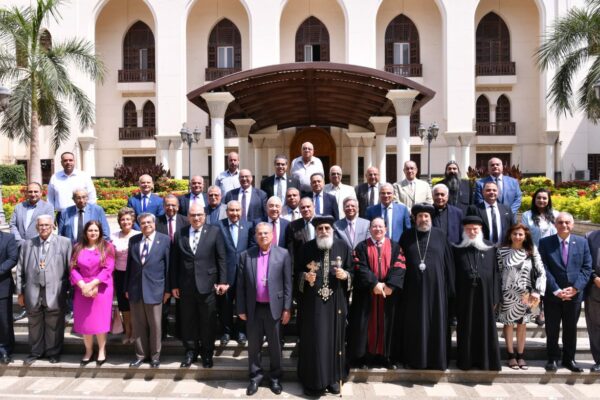His Holiness Pope Tawadros II delivered his weekly sermon at the Wednesday meeting this evening, from the Logos Papal Centre at the Monastery of Saint Bishoy in Wadi El-Natroun. The sermon was broadcast on Christian satellite channels and the C.O.C channel of the Church’s Media Centre on the Internet.
His Holiness addressed part of the fourth chapter of the epistle of our teacher St. Paul the Apostle to the Ephesians, verses (1-3), and pointed out that this chapter is “the jewel of the Epistle to the Ephesians” because it explains the educational curriculum for Christian behaviour and the life of discipleship, as guidance for servants who are candidates for the priesthood and will be ordained tomorrow morning.
His Holiness the Pope explained the life of discipleship and that it includes three common meanings, which are:
1. Discipleship is the life of Christ: it is a life you live imitating Jesus Christ
2. Discipleship is love: it is love for the thing you will learn, whether a person or a book that builds the spiritual entity
3. Discipleship is wisdom: a person must learn wisdom from the person he is apprenticed to, whether in speech or in behaviour
His Holiness recommended that we ask for wisdom from God every day, and pointed out that discipleship is a beginning in a person’s life that never ends, and it is the focus of Christianity in service and monasticism, and requires obedience to the one being discipled, through commitment to Christ and a connection to fellowship with him, then H.H. discussed the forms and types of discipleship, as follows:
1. Discipleship of the thought: The first thing that builds a person’s mind is the Word of God, “The words that I speak to you are spirit, and they are life” (John 6:63), and the discipleship of
the thought includes:
Discipleship of the Gospel: A person must commit to reading the Gospel constantly, without filtering or choosing, in order to be satisfied and live in the depth of the Word of God.
Discipleship from the teachings of the saints: for a person to search in the writings of the fathers for consensus in opinion, such as the writings of Saint John Chrysostom.
Discipleship by mentors: A person must commit to obeying his father of confession and his spiritual guide, in complete humility.
2- Discipleship of the senses:
It includes a number of terms , such as: discipleship of the eyes on icons, the relics of saints, and church rites, discipleship of the nose on incense and spices, discipleship of the ear on rising prayers, praise and chanting, as well as raising the hands, beating the chest, and bowing with the feet in order to search for others, so that a person is busy day and night with God.
3- Discipleship of the heart:
It is the discipleship of the doctrine, which is a feeling within a person of the faith that he contains, because doctrine is life, just as the living faith was among the martyrs, and the discipleship of the heart is the one in which a person lives the liturgical life in prayers and the practice of the sacraments, and not only practices them from a ritual standpoint.
His Holiness also explained that one of the features of true discipleship is “balance,” because a good student must have wisdom and moderation through several principles, which are:
1- Authenticity and modernity: an example of faith and science and how we feel about granting blessings in holy places, as well as how we face the constant conflict between the old and the modern and accept the modern and be present in it appropriately.
2- Material and spiritual: such as the balance between social activity and spiritual activity.
3- Freedom and commitment: such as the balance between isolation and freedom with conscious commitment, and just as Saint Athanasius in the fourth century AD explained theology, faith, and doctrine with the prevailing philosophy at that time.
This page is also available in:
العربية










